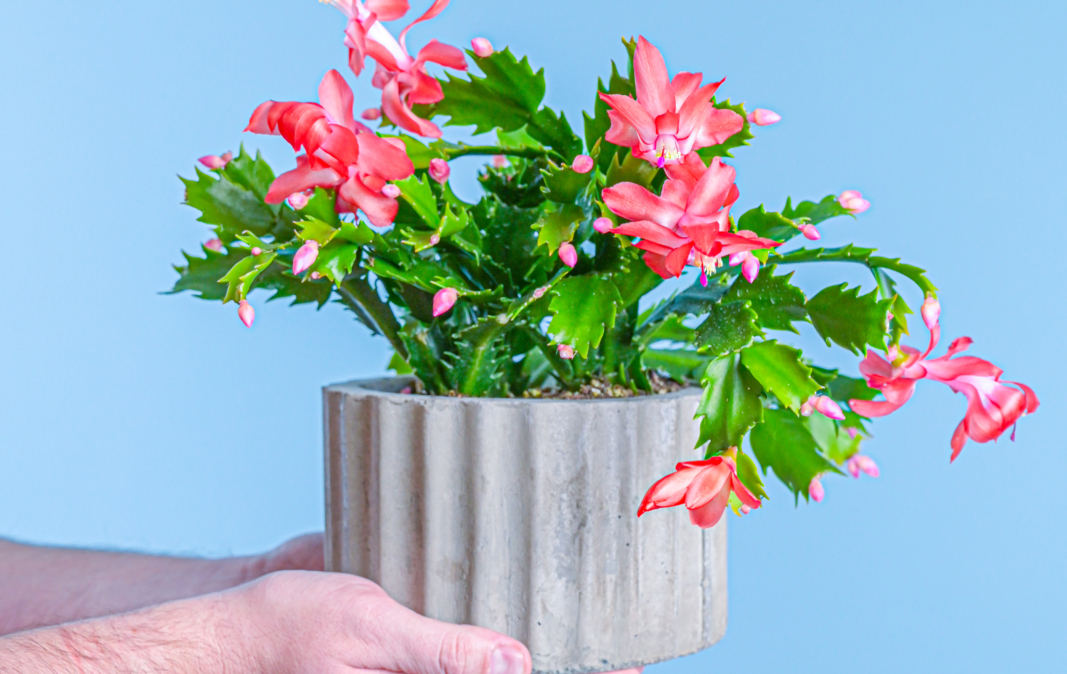 Bryn Wallace
Bryn WallaceHoliday Cactus Care Guide
The popular Christmas Cactus, which is native to Brazil, is actually one of three types of cactus named based on their bloom time: the Thanksgiving Cactus, Christmas Cactus and Easter Cactus. You may see these cacti collectively referred to as holiday cactus as they are all very similar plants. The Thanksgiving variety blooms in November, the Christmas variety blooms from mid to late December, and the Easter cactus blooms in the spring. Apart from their bloom time, the primary way to tell them apart is by their leaf shape: the Christmas cactus has more rounded points to its leaves than the Thanksgiving cactus, while Easter cacti have spikier blooms and more oval-shaped leaf segments. Since all require similar care, you can find everything you need to care for all three in this guide.
How to Select Your Holiday Cactus
Holiday cacti have succulent leaves and spiky, colorful blooms that come in just about every color, from shades of red, pink and purple to white, orange and gold. After selecting your preferred color, keep an eye out for plants that hold themselves up well, with leaves that are full and not wrinkled. If the plant is floppy or droopy and the leaves wrinkled or too flat it is in need of water. Alternatively, if the leaves are mushy and brown or black, the cactus has been sitting in too much water and its roots may be rotting. Holiday cactus can quickly be killed by overwatering and root rot.
If you wish to ensure a long period of bloom after bringing your plant home, look for a plant that not only has blooms, but plenty of new buds. These buds will open gradually as the blooms on the plant when you purchased it finish, extending the bloom time significantly.
If the weather is below 50 degrees when you purchase your holiday cactus, Merrifield employees will put a paper or plastic sleeve over the plant to protect it from the cold air. Bring your plant indoors immediately upon arriving home to ensure that the plant remains protected from cold weather.
Finding the Best Location for Your Holiday Cactus
Holiday cacti enjoy bright, indirect light and will do well in a south, east or west facing window. Be aware that too much sunlight may burn the plant’s leaves. If you notice the leaves of your cactus are becoming sunburned, move your plant a little farther away from the window into less direct light. Place it a safe distance from hot air vents or a fireplace, as hot, dry air will stunt the growth of the plant and burn the leaves. If you see that your plant is dropping a few buds after you bring it home, there’s no need to worry. Holiday cacti are temperamental about being moved, but they generally bounce back just fine from a change in scenery. If you find that your plant is still dropping buds after more than a month, it may not like its new location or the amount of water it is receiving. Try moving your holiday cactus to a location with brighter sun, and it should stop dropping buds.
Watering and Fertilizing Your Cactus
Like most other succulents, holiday cactus do not like to sit in moist soil and will develop root rot if allowed to sit in wet soil for too long. Allow the soil to dry out somewhat between watering. A good rule of thumb is to check the plant once a week or so by poking your finger into the soil. If your finger picks up a lot of residue from the soil, you should leave it be for three to four days before you water it again. When watering, pour directly into the soil rather than on the top of the plant.
Holiday cactus perform especially well when using a bloom booster, such as Jack’s Blossom Booster, every three or four weeks while in bloom. Holiday cactus does not need a specialized cactus soil, but should be placed in well-draining soil with added perlite or pumice.
Care After the Holiday Cactus Bloom Cycle
After your holiday cactus finishes blooming, keep it in a cool spot of around 55 degrees and water it only periodically. When summer comes around, you can place the cactus outside in a shady spot, where it will benefit from filtered light humidity. To induce blooming in the fall, outdoors as the temperatures begin to drop into the 50s and 60s. When temperatures drop below 45 degrees fahrenheit, you should bring the plant back inside and start watering more frequently, checking the soil every week or so.
Holiday cacti are easy to propagate. If some of your leaves break off, you can plant them in a very small pot. Add some rooting hormone, if you wish. You can place your cuttings on a bright windowsill and they will slowly grow into a new plant. Repot your plants into a pot just one size larger than your previous pot after they finish blooming.


 Bryn Wcllace
Bryn Wcllace